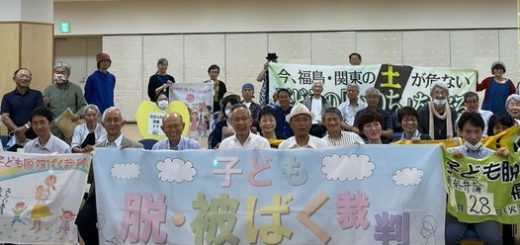Onagawa Reactors Trip Following Miyagi Earthquake Nuke Info Tokyo No. 108
 On August 16th all three reactors tripped automatically at Tohoku Electric Power Company’s Onagawa Nuclear Power Plant in response to a magnitude 7.2 earthquake off the coast of Miyagi Prefecture. The direct reason was that the quake exceeded the level set to trigger an automatic trip, in this case a horizontal acceleration of 200 gal1 (table 1).
On August 16th all three reactors tripped automatically at Tohoku Electric Power Company’s Onagawa Nuclear Power Plant in response to a magnitude 7.2 earthquake off the coast of Miyagi Prefecture. The direct reason was that the quake exceeded the level set to trigger an automatic trip, in this case a horizontal acceleration of 200 gal1 (table 1).
This was the third time that a reactor at the Onagawa NPP has tripped automatically because of an earthquake. The first time was in response to a magnitude 5.9 quake in the north of Miyagi Prefecture on 27 November 1993. On that occasion reactor 1 tripped. Power increased rapidly, but the control rods inserted successfully. According to the manufacturer, the reason for the sudden increase in power was the shaking of the fuel assemblies. The second time was in response to a magnitude 7.1 quake off the Miyagi coast on 27 May 2003. On that occasion reactor 3 tripped. Reactors 1 and 2 were closed for periodic inspections at the time. An acceleration of 225 gal was recorded.
In this latest incident, besides cracked glass in an observation gallery in the reactor 3 building, 45 liters of sulfuric acid leaked from a tank on the roof of the environmental radioactivity measurement center building. As of September 2, checking of reactor 2 equipment was 30 percent complete, but no safety problems had been found. However, we are very concerned to know whether the control rods inserted within the specified time, what happened to the reactor pressure and the water level, whether cracks in the shroud and piping were affected, etc., etc..
Besides Onagawa, reactors at Higashidori, Fukushima I, Fukushima II, Kashiwazaki-Kariwa and Tokai were either already shutdown for one reason or another, or continued to operate. However, at Fukushima I – 2 & 6 and Fukushima II – 4 water leaked from spent fuel pools through vents and ducts into the containment vessel.
This time the quake exceeded the design basis for Onagawa NPP. The Japanese NPP design rules specify two classes of earthquake. The first class is the ‘design-basis strongest earthquake’. This is hypothesized based on earthquakes which have occurred at active faults within the past 10,000 years. The second class is the ‘design-basis upper limit earthquake’. This is hypothesized based either on earthquakes which have occurred at active faults within the past 50,000 years, or on a magnitude 6.5 earthquake directly below the NPP. Simply stated, from the standpoint of NPP designers, the ‘design-basis strongest earthquake’ is the largest earthquake that might realistically be expected to occur, whereas the ‘design-basis upper limit earthquake’ is unlikely to occur, but is taken into account just in case. Table 2 shows the anticipated quake size listed in the site applications for the three Onagawa reactors for each of these types of earthquake.
On August 16th, a maximum of 251.2 gal was recorded at the base (second floor basement) of the Onagawa-1 reactor. This exceeds the maximum acceleration of the ‘design-basis strongest earthquake’. However, subsequent analysis of data from the bedrock showed that for some periods of the response spectrum, the movement exceeded the ‘design-basis upper limit earthquake’. This was revealed in an announcement made by Tohoku Electric on September 2nd. On the same day, the Nuclear Industrial and Safety Agency (NISA) said that it took this matter very seriously and requested that Tohoku Electric provide a detailed analysis of the capacity of safety-significant equipment to withstand earthquakes. It also requested an analysis of the reason why the response spectrum for the surface of the bedrock exceeded the response spectrum for the ‘design-basis upper limit earthquake’. However, the fact that these design basis limits have been exceeded shows that the utilities and NPP makers design assumptions are inadequate. It also exposes a serious failure of the government’s safety assessment system.
Facilities and equipment such as the following are all very important for reactor safety, but they are only required to be capable of withstanding the ‘design-basis strongest earthquake’: the emergency core cooling system, pumps valves and pipes of the residual heat removal system, the core shroud, the suppression pool as a source of coolant, the central control room, and the reactor building. It would not be at all surprising if some of these have been damaged. Other equipment (for example, the main steam system, the turbines, and pumps valves and pipes of the feedwater system) is not even required to be capable of withstanding the ‘design-basis strongest earthquake’.
Tohoku Electric’s response to this was, “We plan to restart the reactors after confirming that the reactor containment vessel, the emergency core cooling system and so on are in sound working order.” This laid back approach shows that they don’t understand the seriousness of the problem. A major design defect of the reactors at the Onagawa NPP has been exposed. NISA should revoke their operating licenses.
Chihiro Kamisawa (CNIC)



